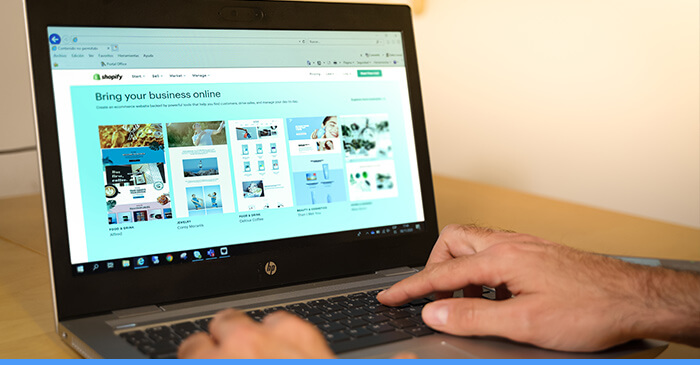
Headless commerce means using a different technology for the front and back end of your e-commerce website. This decoupling increases the flexibility of your storefront. They are well-known e-commerce platforms or back-ends that provide headless flexibility with a front-end layer you may utilize on top. The back-end functionality and the front-end layer’s shopping experience of the Shopify Headless e-commerce are managed separately.
What is Shopify Headless?
This headless commerce configuration separates the back end (Shopify Plus) from the front end (the presentation layer). The connecting thread between the two is an API. However, a standard Shopify platform’s front and back ends are integrated. When using Shopify Headless, you can create the front end from scratch using whatever technology or framework you wish. Shopify is usually the back end. So, in addition to Shopify Plus’s agility, security, and user-friendliness, you also receive creative freedom that goes far beyond the limits of Shopify development.
How Does Shopify Headless Work?

The following systems are used to build the back end of e-commerce websites to house and manage content shared with the customers.
- Content Management System
- Digital Experience Platform
- Progressive Web App
- Customer Relationship Management
What Are the Benefits of Shopify Headless?
Customers and businesses can benefit from Headless Shopify. A headless strategy liberates you from the constraints of single-stack software from a commercial perspective. By isolating the front-end design, you may fully manage the creative process to create an aesthetically pleasing and intuitive website. A compelling website is a fantastic method to keep your visitors satisfied and returning to your store. According to research, 58% of people cease to work with a company due to a bad customer experience. A slow or awkward website is a surefire way to give visitors an unpleasant time.
You may reach your target audience through all channels thanks to the adaptability of headless commerce. E-commerce teams are agile in customizing tone, content, and graphics, especially in larger firms. They don’t require access to the back-end platform to make immediate adjustments to digital stores. Without them being connected to the front-end development procedure, you nevertheless have access to all the tools required to market your products and oversee a warehouse successfully.
Tips for Shopify Headless Commerce

1. Do your research
While Shopify Headless commerce may seem easy, there is much more to it. Do your research, including cost analysis, development and implementation plans, internal and external obstacles, and other crucial elements that may affect your shift to a headless store. It’s important to remember that not all of this will be accessible inside. When deploying Headless Shopify commerce, it can be helpful to look at how and what has worked well for others. Understanding their problems may also save you from making the same errors.
2. Focus on the customer’s needs
You can separate your front and back ends with Headless Shopify e-commerce, which makes it simpler and more flexible to make creative changes to your front end. However, having creative control has its advantages and disadvantages. Customers may leave your website if it is overly complicated and challenging. As you work on the consumer-facing side of your storefront, keep in mind the demands of the client and the customer journey. Front-end optimization aims to satisfy customers and encourage them to take the required action.
3. Build a Shopify technology stack
Your ERP, PIM, CRM, and CMS software can integrate with Shopify Headless e-commerce. Therefore, you are not required to abandon parts of your current technology stack. Instead, you can build a Shopify technology stack that meets your requirements and is compatible with the Shopify software. Doing this allows you to handle everything fluidly instead of breaking your system up. You may more quickly and confidently recognize patterns, retrieve pertinent data, and make decisions based on that data with a strong cross-platform interface.
4. Omnichannel optimization
Integrating physical stores and online shopping has long been part of an omnichannel experience. Omnichannel refers to going beyond desktop and mobile as consumers grow more tech aware. You may want to broaden your audience even further, even if some websites might only be accessible on desktop and mobile. People on various gadgets, such as smartwatches and displays for smart homes, are increasingly consuming digital material. For a great consumer experience everywhere, you can connect to and enhance your storefront using Headless Shopify commerce.
5. Budget & project outline
Those who want a Headless Shopify store must create their own from the ground up since no existing Shopify themes currently allow it. If you decide to do so, it will be important to set realistic expectations. This includes drafting a project overview, budget, and implementation schedule. The project description will determine the workflow, individual or departmental responsibilities, and anticipated completion dates for each segment. Starting a process without adequate planning and management is not a good thing to do.
6. Allocate migration time
Owners of online stores already use Shopify benefits because they do not have to migrate to a different platform. Starting with Shopify makes adoption easier and accelerates execution. However, you can still switch to Shopify headless commerce if your store runs on a different platform. Do your homework to find out how to accomplish the migration with the fewest possible roadblocks before leaping. A comprehensive migration checklist will assist you in estimating completion dates and allocating the appropriate tasks to your development team.
7. Find the right tools
You might not have access to some of the Shopify applications if you abandon the conventional method of using a website design. Since adopting Shopify Headless e-commerce is a goal, you can construct something even better in the new front-end design, but you should first anticipate your needs and look for viable alternatives. Identifying which apps are compatible with Shopify’s API is important while searching for app replacement choices.
8. Conversion optimization
The average conversion rate for e-commerce websites is 2.7%, per Semrush data. There is much potential for improvement with that figure. Aspects of design and SEO for your headless Conversions should be the main goal of the Shopify website. Top-selling goods and services should be highlighted on optimized landing pages.
9. Store audit & analysis
Shopify is not something you can set and forget, just like any other internet presence. Conduct regular audits of your establishments to find any problems that affect client experience and search for methods to enhance your storefront. This might be as simple as adding extra CTA buttons or upgrading the images or descriptions of the products or services. However, only some things are obvious. Additionally, a deeper analysis of website analytics should be conducted for issues like high bounce rates, conversion rates, new and recurring visitors, and more.
10. Get support
You can work with others to build a Shopify Headless store. Ask credible third parties for help if your team cannot build or migrate to a Shopify headless commerce. If you decide to do this, thoroughly investigate the availability, company success stories, and third-party assistance choices.
Conclusion
Shopify Headless has been very popular recently. This new, innovative CMS is turning heads with its remarkable speed, great performance, and better security features. Many people still need to understand what Headless Shopify is, how it functions, or whether they should use it. You can find everything you need about Shopify Headless in this blog.
Arturo Digital can assist you with website and application design for your e-commerce brand. Contact Arturo Digital by dropping an email.
Read more: Why You Should Activate SSL Pending for Your Shopify Store